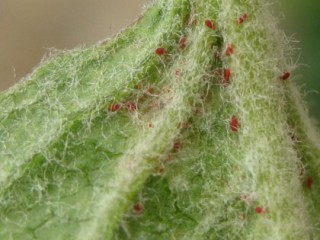
The flat scarlet mite has long been known as a minor pest of apples and occasionally pears in the UK. The females in particular are easily distinguished from other mites.
Flat scarlet mite is a relatively sedentary pest which tends to live in groups with a simple life cycle. It overwinters as fertilised females on the bark of apple. They become active in early spring, from April onwards, and invade the foliage and flower/fruit clusters in May.
The first eggs are laid on the wood late in April but subsequently eggs are laid along the midrib, beneath the leaf hairs. Eggs hatch from late June onwards.
Large numbers of mites feeding on foliage and developing fruits have a severe adverse affect on tree health and fruit quality.
Damage to the upper leaf surface starts with yellowing close to the veins which later develops into necrotic patches. Mites also cause bronzing damage to the lower leaf surface in much the same way as fruit tree red spider mite and apple rust mite.

Leaves develop necrotic areas at the base and shrivel and drop prematurely if infestation is severe. Mites feeding around the eye and sometimes the stalk of Cox and other varieties cause severe russet. Damage spreads onto the cheek in severe attacks.
Mating takes place in August and September. The males die and fertilised females migrate to the bark where they overwinter. There is one generation per year.
Populations have been increasing in apple orchards in recent years and damaging populations have developed in some orchards in the fruit growing areas in the UK so monitoring is important.
